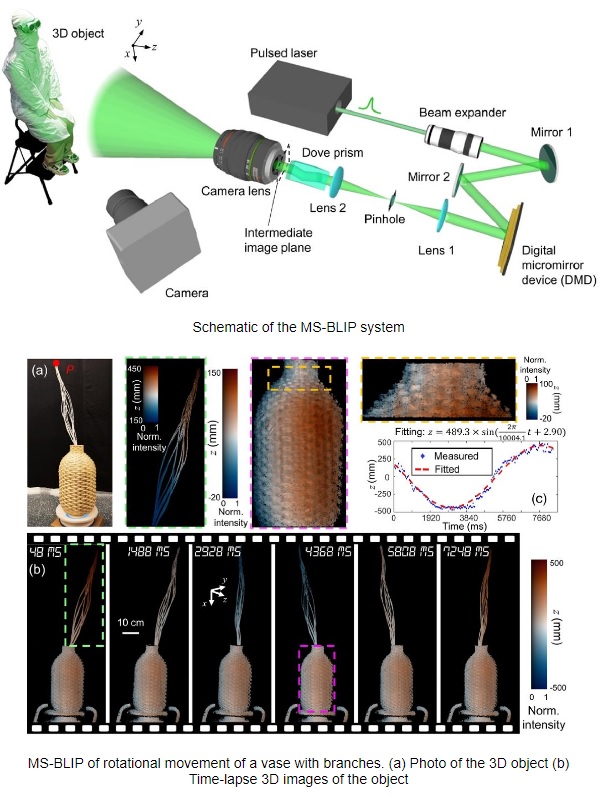| Profilometry is an imaging technique used to extract topographical data from a surface in order to obtain surface morphology, step heights and surface roughness. Dynamic 3D surface imaging by phase-shifting fringe projection profilometry (PSFPP) has been widely implemented in diverse applications, including industrial manufacturing, archaeological inspection, entertainment, and biomedicine. PSFPP works by first projecting sets of phase-shifting sinusoidal fringe patterns onto 3D objects and then analyzing deformed structure images reflected from the objects to retrieve 3D surface information. Existing PSFPP techniques have fallen short in simultaneously providing the robustness in solving spatially isolated 3D objects, the tolerance of large variation in surface reflectance, and the flexibility of tunable working distances with meter-square-level fields of view at video rate. To overcome these limitations, researchers at the INRS Énergie Matériaux Télécommunications Research Centre in Quebec, Canada developed a technique they termed Multi-Scale Band-Limited Illumination Profilometry or MS-BLIP. Supported by the synergy of dual-level intensity projection, multi-frequency fringe projection, and an iterative method for distortion compensation, MS-BLIP can accurately discern spatially separated 3D objects with highly varying reflectance. The MS-BLIP system begins with a pulsed laser used as the light source. After expansion and collimation, the beam is directed to a 0.45” DMD (Digital Micromirror Device) at an incident angle of ∼24° to its surface normal. Binary fringe masks, generated by an error diffusion algorithm from their corresponding grayscale patterns, are loaded onto the DMD and displayed at up to 1 kHz. A band-limited 4f imaging system that consists of two lenses and one pinhole converts these binary patterns to grayscale fringes at the intermediate image plane. The smallest period in the used sinusoidal fringe patterns is 388.8 µm, which demands a 150-µm-diameter pinhole to pass the spatial frequency components of these patterns while filtering all noise induced by the digital half-toning. A dove prism rotates the generated fringe patterns to match the aspect ratio of the targeted scene. Then, a camera lens (AF-P DX NIKKOR 10-20mm f/4.5-5.6G VR, Nikon) projects these fringe patterns onto 3D objects. The deformed structure images are captured by an Optronis CP70-1HS-M-1900 CoaXPress camera with an Azure lens. Synchronized by the DMD’s trigger signal, the acquired images are transferred to a computer via a cable to a BitFlow Cyton-CXP CoaXPress frame grabber built on a half-size x8 PCI Gen 3.0 express board compliant with the CXP 1.1 standard. CoaXPress (CXP) is an asymmetric high-speed point-to-point serial communication standard for the transmission of video and still images, scalable over single or multiple coaxial cables. It has a high speed downlink of up to 12.5 Gbps per cable for video, images and data, plus a lower speed uplink up to 42 Mbps for communications and control. Power is also available over the cable (“Power-over-Coax”) and cable lengths of greater than 100m may be achieved. “Applications for CoaXPress are evolving with new use cases being found in precise medical research and 3D inspection where Camera Link or GigE Vision previously were the go-to standard,” said Donal Waide, Director of Sales for BitFlow, Inc. “Speed combined with stability, plus a growing choice of compatible cameras, have sparked a great deal of interest for CoaXPress in laboratory settings.” To demonstrate MS-BLIP’s potential in industrial inspection, researchers imaged the rotational movement of a bamboo vase with extending branches rotating at 0.6 rad/s. MS-BLIP was operated at a working distance of 2 meters (m), with an FOV of 1.5 m × 1.0 m, and at a 3D imaging speed of 20.8 frames-per-second (fps). Under these working conditions, the depth resolution was quantified to be 3.7 mm, and the lateral resolution was measured to be 1.7 mm. Close-up views of the vase presented detailed structural information on its surface with depth-encoded color changes of the branches reflecting the rotation movement of the object. Along with testing with the rotational movements of a craft vase, MS-BLIP also proved successful in the dynamic 3D visualization of translational movements of an engineered box, and full human body movements at a measurement volume 3X greater than existing BLIP systems. Future work will be carried out to improve MS-BLIP’s imaging speed by adopting multiple cameras, a faster DMD, and a more powerful light source. Besides technical improvement, the researchers will continue to explore new applications including automated industrial inspection human-computer interaction. |
| High-speed dual-view band-limited illumination profilometry using temporally interlaced acquisition C Jiang, P Kilcullen, Y Lai, T Ozaki, J Liang Photonics Research 8 (11), 1808-1817, May 2022 |

